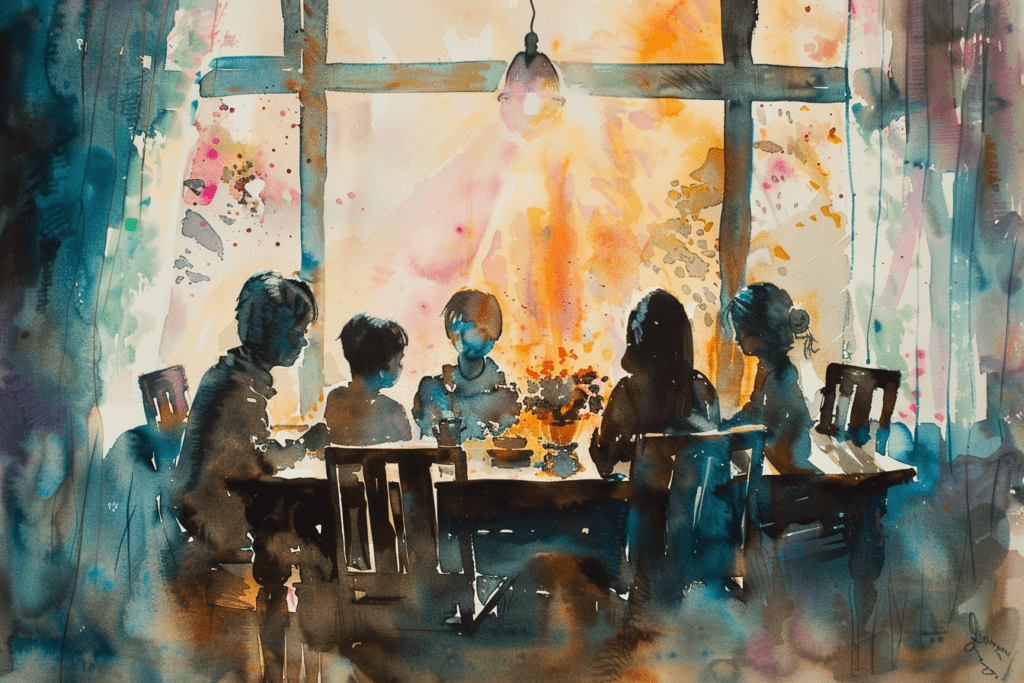
Involving Family and Friends When Creating A Funeral Order Of Service Booklet



Introduction

Creating a funeral memorial booklet is a deeply meaningful way to honour and remember a loved one who has passed away. This keepsake serves as a lasting tribute, capturing the essence of the deceased’s life, their achievements, and the impact they had on those around them.
Involving family and friends in the creation of this booklet not only enriches its content but also provides a collaborative healing process for everyone involved.
This article explores the various ways in which family and friends can contribute to the making of a funeral memorial booklet, ensuring it becomes a cherished tribute that reflects the unique spirit of the departed.
Article Contents
- The Importance of Collaboration
- Gathering Contributions
- Structuring the Booklet
- Personal Touches
- Ensuring Inclusivity
- Finalising and Distributing the Booklet
- Additional Considerations
- Conclusion

The Importance of Collaboration

Shared Memories
One of the most significant benefits of involving family and friends in creating a funeral memorial booklet is the wealth of shared memories they can contribute.
Each person had a unique relationship with the deceased, and their recollections help paint a fuller picture of the person’s life. Encouraging family members and friends to share their favourite stories, anecdotes, and experiences can provide a diverse and rich narrative that would be impossible to achieve alone.
When gathering these memories, it’s important to prompt contributors with questions that can elicit detailed and heartfelt responses. For example, asking about a specific event or characteristic of the deceased can bring out unique stories and perspectives.
This approach not only ensures a variety of content but also helps those contributing to recall specific and meaningful memories.
Emotional Support
Grieving is a complex and deeply personal process, but it can be eased by the support of others. Working together on a project like an order of service booklet allows family and friends to offer each other emotional support.
The act of remembering and honouring a loved one collectively can foster a sense of community and shared grief, making the process of mourning more bearable.
The collaborative nature of creating your booklet can also help to alleviate feelings of isolation that often accompany grief. When people come together to share their experiences and memories, they create a support network that can provide comfort and understanding.
This communal approach to grief can be especially important for those who may be struggling to cope with their loss.

Gathering Contributions

Organizing a Collection Process
To effectively gather contributions from family and friends, it’s essential to have an organised collection process. This can be achieved by setting up a centralised system where everyone can submit their memories, stories, and photos.
Digital tools such as shared folders, email, or dedicated online platforms can facilitate this process, ensuring that all contributions are collected in one place and can be easily accessed and compiled.
Creating a timeline for contributions can help keep the project on track. Setting deadlines for submissions ensures that the process moves forward and that there is ample time for editing and assembling the booklet.
Clear communication about these deadlines and the submission process is crucial to ensure that everyone is on the same page.
Encouraging Participation
Not everyone may feel comfortable contributing right away. It’s important to reach out and encourage participation in a sensitive and understanding manner.
Personal invitations, whether through phone calls, letters, or emails, can make individuals feel valued and more inclined to share their memories. Providing clear instructions and examples can also help those who might be unsure about what to contribute.
In addition to personal invitations, group discussions or family meetings can be an effective way to encourage participation.
These gatherings provide a space for people to share their thoughts and memories collectively, which can then be documented for the booklet. This approach not only generates content but also strengthens the bond among family and friends during a difficult time.

Structuring the Booklet

Creating a Narrative
Once all contributions are gathered, the next step is to create a coherent narrative for the booklet. This involves organising the material in a way that tells the story of the deceased’s life.
Start with a biography that covers key milestones, followed by sections dedicated to various aspects of their life, such as childhood, career, hobbies, and relationships. Including quotes from family and friends throughout the booklet can enhance the narrative and provide personal insights into the deceased’s character.
A chronological structure is often effective for an order of service booklet, as it allows readers to follow the life story of the deceased from beginning to end.
However, thematic sections can also be powerful, particularly if the deceased had specific passions or interests that defined their life. For example, separate sections could be devoted to their professional achievements, hobbies, community involvement, and family life.
Designing the Layout
The design and layout of the booklet are crucial for its readability and emotional impact. Choose a layout that is clean and easy to follow, with distinct sections and headings.
High-quality photos and thoughtful placement of text can make the booklet visually appealing and meaningful. Consider using a mix of candid and formal photos to capture different facets of the deceased’s life.
Design elements such as borders, background colors, and fonts should be chosen with care to reflect the personality and preferences of the deceased.
For instance, if they had a favourite color or flower, these can be incorporated into the design. Additionally, the layout should be balanced, with an appropriate mix of text and images to maintain reader engagement.

Personal Touches

Incorporating Letters and Messages
Personal letters and messages from family and friends can add a deeply personal touch to the memorial booklet. These can be expressions of love, memories, or reflections on the deceased’s impact on their lives.
Including these heartfelt messages can provide comfort and a sense of connection for those reading the booklet.
To gather these letters and messages, consider reaching out to a wide circle of the deceased’s acquaintances. This might include not only close family and friends but also colleagues, neighbours, and members of community groups the deceased was part of.
The diversity of voices can enrich the content and provide a fuller picture of the deceased’s life and impact.
Poems and Readings
Including poems, readings, or quotes that were meaningful to the deceased or resonate with their personality can add depth to the booklet.
These can be religious texts, literary excerpts, or even original poems written by family members or friends. Such additions can evoke emotions and offer solace to those grieving.
When selecting poems and readings, consider the deceased’s personal tastes and beliefs. If they had a favourite poet or author, including their work can be a fitting tribute.
Alternatively, family members may choose to write original poems or reflections that capture their feelings and memories of the deceased. These personal contributions can be particularly poignant and meaningful.
Please see our article ‘Poems for a Funeral Order of Service Booklet’ for some examples.

Ensuring Inclusivity

Honouring Diverse Relationships
Involving a broad range of family and friends ensures that the booklet honours the diverse relationships the deceased had.
It’s important to include contributions from different generations, cultural backgrounds, and social circles. This diversity can enrich the content and reflect the many dimensions of the deceased’s life.
To achieve this inclusivity, make a conscious effort to reach out to individuals who may not be in the immediate family circle but who had significant relationships with the deceased.
This might include childhood friends, former colleagues, or members of social or religious groups. Their perspectives can add valuable depth and breadth to the memorial booklet.
Sensitivity and Respect
Creating your order of service booklet requires sensitivity and respect for the deceased and their loved ones. Ensure that the content is appropriate and considerate, avoiding any material that could cause distress.
It’s essential to review all contributions with care, seeking feedback from close family members to ensure that everything included is respectful and fitting.
When reviewing contributions, it may be helpful to designate a small committee of close family members to oversee the process. This group can provide input on the suitability of content and help ensure that the booklet accurately reflects the deceased’s life and character.
Their involvement can also help prevent any potential conflicts or misunderstandings.

Finalising and Distributing the Booklet

Proofreading and Editing
Before finalising the booklet, thorough proofreading and editing are necessary to ensure accuracy and quality. Check for any grammatical errors, typos, and ensure that all names, dates, and facts are correct.
It’s also important to review the booklet for clarity and coherence, making sure the narrative flows smoothly.
In addition to basic proofreading, consider seeking feedback from a few trusted individuals who can provide a fresh perspective. They may catch errors or inconsistencies that have been overlooked and can offer suggestions for improving the overall presentation.
This step is crucial for ensuring that the final booklet is polished and professional.
Printing and Distribution
Once your booklet is complete, choose a high-quality printing service to produce the final copies. Consider printing enough copies for all immediate family members and close friends.
Additionally, digital copies can be created and shared with a wider circle of acquaintances who may not be able to attend the funeral but still wish to have a memento.
When selecting a printing service, look for one that offers options for customisation and high-quality finishes. This can include choices of paper type, binding, and cover design.
These details can enhance the overall presentation and make the booklet a treasured keepsake. Additionally, consider creating a digital version of the booklet that can be easily shared via email or social media.

Conclusion

Creating a funeral order of service booklet is a heartfelt way to commemorate a loved one’s life and legacy. By involving family and friends in the process, the booklet becomes a richer, more comprehensive tribute that honours the deceased in a deeply personal way.
The collaborative effort not only results in a cherished keepsake but also provides a therapeutic experience for those grieving. Through shared memories, emotional support, and collective creativity, the memorial booklet can serve as a lasting reminder of the love and impact the deceased had on their community.







